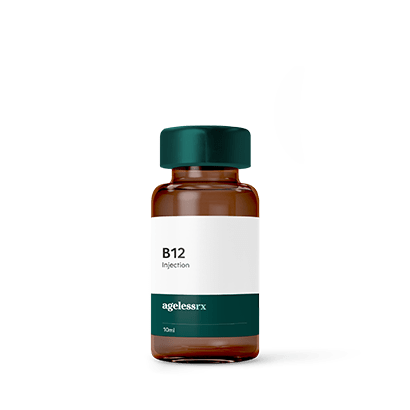B12 Injection Product Guide
Also known as cobalamin, Vitamin B12 has been praised as a simple solution for energy, sleep, mood, weight loss, and a diverse range of other health benefits. Like many essential nutrients, Vitamin B12 can’t be produced by our bodies, which makes B12 supplementation vital for our well-being.
Quick tips
Here are some simple steps to help you get the most from each dose:
- Always leave your vials at room temperature
- Use with a reduced-calorie meal plan & exercise
- Take with or without food
- Rotate injection sites at least every week
- Be sure to properly discard your vials & syringes
Getting started
When you first receive your B12, ensure proper storage guidelines to maintain the quality of the solution.
Follow the instructions for properly drawing and administering B12.
Always dose according to your doctor-guided titration schedule.
Storage

Keep your B12 vials at room temperature and away from direct sunlight to maintain the utmost quality. Store away from where your pets and children can reach.
Separate any used vials from your unused vials. Always dispose of any syringes immediately after use, and always in a sharps disposal container.
After 30 days, you must discard your vial, even if there is still some solution remaining – this applies to all multi-dose vials (MDVs).
Upon receiving your B12, check the temperature of the vials with the back of your hand. If it feels hot to the touch, please contact us immediately.
You may safely travel with your B12 vials so long as the above conditions are met while traveling. It may be necessary to travel with a temperature-controlled case to ensure that your B12 vials remain as close to room temperature as possible during transit. Be sure to bring your own sharps disposal container if you will not have access to one.
Drawing and administering B12
How to draw your solution
Before your first use, take the time to review how to properly draw your solution.
Next, ensure that you are drawing the correct amount of solution according to your titration schedule. Your current dose will always be displayed on your vial – use this as a reminder before you begin.
It is important to sterilize the top of the vial with an alcohol wipe each time before drawing up the solution.
How to administer your solution
B12 is delivered via subcutaneous injection, which means that you will inject the solution into a fatty layer of skin such as the back of your arms, your thigh, or your abdomen. If you’re new to self-administered injections, take the time to review how to properly administer your injection before proceeding.
As a general rule, you should grip the syringe with your dominant hand, and grasp the injection site with the other hand.
Subcutaneous injections can be delivered and removed at a 90° angle (or, straight in) if you can easily grasp two inches of skin. If you can only grasp one inch of skin, deliver and remove the injection at a 45° angle. Swiftly inject the needle while the area is relaxed to reduce any pain or tenderness. Hold the syringe straight while using your index finger to gently push the plunger down. Once the solution has been fully administered, remove the needle at the same angle.
To avoid irritation, try switching injection sites on each subsequent use. For example, if you last injected into your right thigh, you can switch another area on your right thigh, or you can switch to your abdomen or the back of one of your arms. You can take B12 with or without food, and at any time of day, but try to be as consistent as possible to ensure the best outcomes.
After you have administered your injection, discard the needle and syringe in an FDA-approved sharps container. Never reuse the needle or the syringe once it has been used.
B12 titration schedule
B12 is always prescribed with a doctor-guided titration schedule to gradually introduce the medication to your body. This way, you have the best opportunity to experience the greatest benefits possible while reducing side effects.
The B12 solution you will receive contains 1000mcg of B12 per ml/cc, or 1ml/cc. This will be your standard measure for titrating your doses.
Start by injecting 1ml/cc per injection once per week. When you feel your body has adjusted to the medication (or, when you don’t feel side effects), you can increase to twice per week.
Side effects
The most common side effects of B12 shots include:
- Headache
- Nausea
- Vomiting
- Diarrhea
- Fatigue or weakness
- Irritation at injection site
- Tingling sensation in hands & feet
If you experience any of these, consider lowering your dose of B12, or reducing how often you take it. You can also alternate the injection site for each subsequent injection to reduce irritation.
The above is only a summary of potential side effects and how to address them. For more information, please reference the Mayo Clinic’s B12 resources, or ask your prescriber.
Important safety information
Do not take B12 injections if you are currently pregnant or breastfeeding, or planning to become pregnant or breastfeed while taking B12 injections. If you become pregnant while taking B12 injections, consult your prescriber before continuing with your next dose.
As with any prescription medication, the dose prescribed is for you and you alone. Do not, under any circumstances, allow anyone else to use your B12 injections.
FAQs
How much B12 is administered per injection?
The solution contains 1000mcg of B12 per ml/cc.
What is the difference between Cyanocobalamin and Methylcobalamin?
Cyanocobalamin and Methylcobalamin are both forms of B12. The only difference is which molecule is attached to the cobalt (cobalamin) ion: the former contains a molecule of the cyano group, while the latter contains a molecule of the methyl group.
Why should I choose an injection over an OTC supplement?
Injections have better bioavailability than oral supplements as they bypass the digestive system completely, providing a direct supply of B12 into the bloodstream to fuel your body. Oral supplements might work for some, however, as we age, our ability to break down oral supplements often decreases.
Additional resources
-

What to Do If You’re Not Seeing Energy Benefits from Vitamin B12 Injections
Not feeling the energy boost from your Vitamin B12 injections? Find out what you can do next with expert advice on your B12 regimen.
-

Why You Shouldn’t Worry About High Vitamin B12 Levels
Learn why high vitamin B12 levels are a safe and normal result of supplementation and how they support your overall health.
-

What Are Alternatives to GLP-1 Treatments?
Discover effective alternatives to GLP-1s like Metformin 2250, B12/MIC, and Acarbose to support weight loss and metabolic health.
